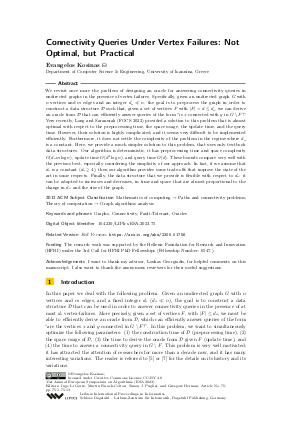Connectivity Queries Under Vertex Failures: Not Optimal, but Practical
Author Evangelos Kosinas
-
Part of:
Volume:
31st Annual European Symposium on Algorithms (ESA 2023)
Part of: Series: Leibniz International Proceedings in Informatics (LIPIcs)
Part of: Conference: European Symposium on Algorithms (ESA) - License:
 Creative Commons Attribution 4.0 International license
Creative Commons Attribution 4.0 International license
- Publication Date: 2023-08-30
File

PDF
LIPIcs.ESA.2023.75.pdf
- Filesize: 0.78 MB
- 13 pages
Document Identifiers
Related Versions
- Full Version https://arxiv.org/abs/2305.01756
Subject Classification
ACM Subject Classification
- Mathematics of computing → Paths and connectivity problems
- Theory of computation → Graph algorithms analysis
Keywords
- Graphs
- Connectivity
- Fault-Tolerant
- Oracles
Metrics
- Access Statistics
-
Total Accesses (updated on a weekly basis)
0Document
0Metadata
Abstract
We revisit once more the problem of designing an oracle for answering connectivity queries in undirected graphs in the presence of vertex failures. Specifically, given an undirected graph G with n vertices and m edges and an integer d_⋆ ≪ n, the goal is to preprocess the graph in order to construct a data structure 𝒟 such that, given a set of vertices F with |F| = d ≤ d_⋆, we can derive an oracle from 𝒟 that can efficiently answer queries of the form "is x connected with y in G⧵F?". Very recently, Long and Saranurak (FOCS 2022) provided a solution to this problem that is almost optimal with respect to the preprocessing time, the space usage, the update time, and the query time. However, their solution is highly complicated, and it seems very difficult to be implemented efficiently. Furthermore, it does not settle the complexity of the problem in the regime where d_⋆ is a constant. Here, we provide a much simpler solution to this problem, that uses only textbook data structures. Our algorithm is deterministic, it has preprocessing time and space complexity O(d_⋆ m log n), update time O(d⁴ log n), and query time O(d). These bounds compare very well with the previous best, especially considering the simplicity of our approach. In fact, if we assume that d_⋆ is a constant (d_⋆ ≥ 4), then our algorithm provides some trade-offs that improve the state of the art in some respects. Finally, the data structure that we provide is flexible with respect to d_⋆: it can be adapted to increases and decreases, in time and space that are almost proportional to the change in d_⋆ and the size of the graph.
Cite As Get BibTex
Evangelos Kosinas. Connectivity Queries Under Vertex Failures: Not Optimal, but Practical. In 31st Annual European Symposium on Algorithms (ESA 2023). Leibniz International Proceedings in Informatics (LIPIcs), Volume 274, pp. 75:1-75:13, Schloss Dagstuhl – Leibniz-Zentrum für Informatik (2023)
https://doi.org/10.4230/LIPIcs.ESA.2023.75
BibTex
@InProceedings{kosinas:LIPIcs.ESA.2023.75,
author = {Kosinas, Evangelos},
title = {{Connectivity Queries Under Vertex Failures: Not Optimal, but Practical}},
booktitle = {31st Annual European Symposium on Algorithms (ESA 2023)},
pages = {75:1--75:13},
series = {Leibniz International Proceedings in Informatics (LIPIcs)},
ISBN = {978-3-95977-295-2},
ISSN = {1868-8969},
year = {2023},
volume = {274},
editor = {G{\o}rtz, Inge Li and Farach-Colton, Martin and Puglisi, Simon J. and Herman, Grzegorz},
publisher = {Schloss Dagstuhl -- Leibniz-Zentrum f{\"u}r Informatik},
address = {Dagstuhl, Germany},
URL = {https://drops.dagstuhl.de/entities/document/10.4230/LIPIcs.ESA.2023.75},
URN = {urn:nbn:de:0030-drops-187289},
doi = {10.4230/LIPIcs.ESA.2023.75},
annote = {Keywords: Graphs, Connectivity, Fault-Tolerant, Oracles}
}
Author Details
Funding
The research work was supported by the Hellenic Foundation for Research and Innovation (HFRI) under the 3rd Call for HFRI PhD Fellowships (Fellowship Number: 6547.).
Acknowledgements
I want to thank my advisor, Loukas Georgiadis, for helpful comments on this manuscript. I also want to thank the anonymous reviewers for their useful suggestions.
References
- Michael A. Bender and Martin Farach-Colton. The level ancestor problem simplified. Theor. Comput. Sci., 321(1):5-12, 2004. URL: https://doi.org/10.1016/j.tcs.2003.05.002.
- Timothy M. Chan, Kasper Green Larsen, and Mihai Pătraşcu. Orthogonal range searching on the ram, revisited. In Proceedings of the 27th ACM Symposium on Computational Geometry,, pages 1-10, 2011. URL: https://doi.org/10.1145/1998196.1998198.
- Mark de Berg, Otfried Cheong, Marc J. van Kreveld, and Mark H. Overmars. Computational geometry: algorithms and applications, 3rd Edition. Springer, 2008. URL: https://www.worldcat.org/oclc/227584184.
-
Reinhard Diestel. Graph Theory, 4th Edition, volume 173 of Graduate texts in mathematics. Springer, 2012.

- Ran Duan and Seth Pettie. Connectivity oracles for graphs subject to vertex failures. SIAM J. Comput., 49(6):1363-1396, 2020. URL: https://doi.org/10.1137/17M1146610.
- Evangelos Kosinas. Connectivity queries under vertex failures: Not optimal, but practical. arXiv version, 2023. URL: https://arxiv.org/abs/2305.01756.
- Yaowei Long and Thatchaphol Saranurak. Near-optimal deterministic vertex-failure connectivity oracles. In 63rd IEEE Annual Symposium on Foundations of Computer Science, FOCS, pages 1002-1010, 2022. URL: https://doi.org/10.1109/FOCS54457.2022.00098.
- Hiroshi Nagamochi and Toshihide Ibaraki. A linear-time algorithm for finding a sparse k-connected spanning subgraph of a k-connected graph. Algorithmica, 7(5&6):583-596, 1992. URL: https://doi.org/10.1007/BF01758778.
- Michal Pilipczuk, Nicole Schirrmacher, Sebastian Siebertz, Szymon Torunczyk, and Alexandre Vigny. Algorithms and data structures for first-order logic with connectivity under vertex failures. In 49th International Colloquium on Automata, Languages, and Programming, ICALP, volume 229 of LIPIcs, pages 102:1-102:18, 2022. URL: https://doi.org/10.4230/LIPIcs.ICALP.2022.102.
- Robert Endre Tarjan. Depth-first search and linear graph algorithms. SIAM J. Comput., 1(2):146-160, 1972. URL: https://doi.org/10.1137/0201010.
